Industry News, trenchless people
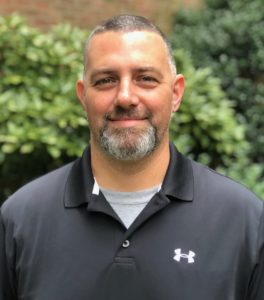 PHILADELPHIA, PA ‐ Pipe Lining Supply is pleased to announce the appointment of Augustus “Gus” Bozzano, II to the position of Technical Representative serving the north eastern USA.
PHILADELPHIA, PA ‐ Pipe Lining Supply is pleased to announce the appointment of Augustus “Gus” Bozzano, II to the position of Technical Representative serving the north eastern USA.
Gus brings many years of plumbing and drain cleaning experience to the new position.
Gus will support Pipe Lining Supply’s customer base with training, advice and sales for CIPP lateral lining and AIPPR pipe coating projects for drain, waste and vent in the Philadelphia and surrounding areas.
Pipe Lining Supply is a leader in the manufacturing and distribution of materials and equipment used in the lateral sewer lining and DWV rehabilitation business. The company was formed to support customers who need training and support as well as the equipment and materials to rehabilitate aging sewer laterals and pipe to restore your pipes to LIKE new condition, extending pipe life 50+ years!
Their goal is to serve the industry with a complete warehouse stocked with the best products at the lowest delivered cost on a timely basis. Visit their website for more information.
Industry News, trenchless products
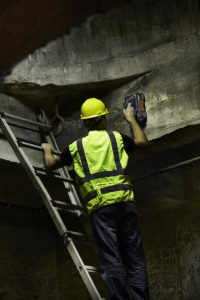 GSSI, the world’s leading manufacturer of ground penetrating radar (GPR) equipment, announces the addition of a new drill hole feature to the StructureScan™ Mini XT – the newest generation of GSSI’s popular all-in-one concrete inspection GPR system. The drill hole feature is a 3D data processing detection algorithm. The algorithm evaluates a user chosen cylindrical area that represents a potential or planned coring location. Scanning for all potential targets within the cylindrical area, the drill hole feature looks for targets that may interfere with a proposed coring location.
GSSI, the world’s leading manufacturer of ground penetrating radar (GPR) equipment, announces the addition of a new drill hole feature to the StructureScan™ Mini XT – the newest generation of GSSI’s popular all-in-one concrete inspection GPR system. The drill hole feature is a 3D data processing detection algorithm. The algorithm evaluates a user chosen cylindrical area that represents a potential or planned coring location. Scanning for all potential targets within the cylindrical area, the drill hole feature looks for targets that may interfere with a proposed coring location.
Available only within the StructureScan Mini XT user interface, the drill hole indicator is designed for concrete coring applications. In complicated slab situations, the drill hole feature can help users determine the safest location for coring concrete. However, this feature is not a substitute for careful analysis by a trained operator, and GSSI does not recommend that the user depend solely on this algorithm for drill hole interpretation.
Operators should receive special training prior to using this new aid. During training, customers can select areas that they believe are safe for coring while the feature is turned off, and turn the feature on to double check and confirm the initial mark outs.
The new drill hole feature will work with all StructureScan Mini XT’s already in the field, and only requires a software update of the system. New units will come with this user interface pre-installed.
About GSSI
Geophysical Survey Systems, Inc. is the world leader in the development, manufacture, and sale of ground penetrating radar (GPR) equipment, primarily for the concrete inspection, utility mapping and locating, road and bridge deck evaluation, geophysics, and archaeology markets. Our equipment is used all over the world to explore the subsurface of the earth and to inspect infrastructure systems non-destructively. GSSI created the first commercial GPR system nearly 50 years ago and continues to provide the widest range and highest quality GPR equipment available today.
Industry News, trenchless products, trenchless projects
Massive XRE Machine breaks through at Akron OCIT
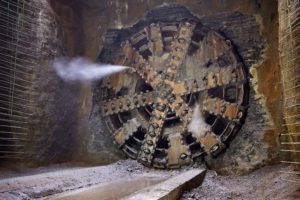 On August 29, 2018, a 9.26 m (30.4 ft) diameter Robbins Crossover (XRE) TBM crossed the finish line at the Akron Ohio Canal Interceptor Tunnel (OCIT). A press day followed on September 5, where companies and members of the media were invited to view the giant machine. The machine—dubbed “Rosie” in honor of Rosie the Riveter, an icon representing American women who worked in factories and shipyards during World War II—overcame tough ground conditions during the bore.
On August 29, 2018, a 9.26 m (30.4 ft) diameter Robbins Crossover (XRE) TBM crossed the finish line at the Akron Ohio Canal Interceptor Tunnel (OCIT). A press day followed on September 5, where companies and members of the media were invited to view the giant machine. The machine—dubbed “Rosie” in honor of Rosie the Riveter, an icon representing American women who worked in factories and shipyards during World War II—overcame tough ground conditions during the bore.
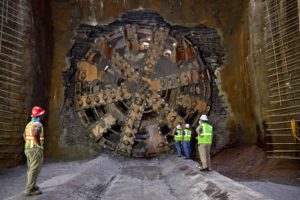 “One of the most challenging aspects of this job was that we launched right into the most difficult part. We had 60 m (200 ft) of soft ground, a very short reach, and then from there we went right into a mixed face for 180 m (600 ft),” said David Chastka, Project Manager for Kenny Construction, a joint venture contractor on the project with Obayashi. “It took everybody we had in the industry, everybody from Robbins, to fight through that first 240 m (800 ft).”
“One of the most challenging aspects of this job was that we launched right into the most difficult part. We had 60 m (200 ft) of soft ground, a very short reach, and then from there we went right into a mixed face for 180 m (600 ft),” said David Chastka, Project Manager for Kenny Construction, a joint venture contractor on the project with Obayashi. “It took everybody we had in the industry, everybody from Robbins, to fight through that first 240 m (800 ft).”
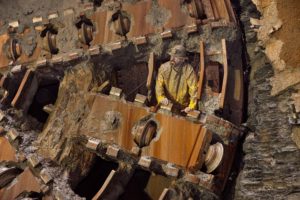 The TBM was designed for the project’s geology, which transitioned from soil to partial face shale to full face shale rock. The Crossover XRE included features of both EPB and Hard Rock Single Shield TBM types, with a versatile cutterhead that could be configured for hard rock or soft ground conditions. While in soft ground and mixed face conditions the machine operated in closed mode, but once it hit solid rock crews switched excavation to open mode. “The machine had the power to get to the other side and made advance rates we never thought we were going to get. It was very successful in hard rock,” said Chastka. Advance rates once in full-face shale rock reached a high of 34 m (111 ft) in one day (two 10-hour shifts). Muck removal was achieved using a Robbins continuous conveyor, and conveyor availability remained high throughout the project.
The TBM was designed for the project’s geology, which transitioned from soil to partial face shale to full face shale rock. The Crossover XRE included features of both EPB and Hard Rock Single Shield TBM types, with a versatile cutterhead that could be configured for hard rock or soft ground conditions. While in soft ground and mixed face conditions the machine operated in closed mode, but once it hit solid rock crews switched excavation to open mode. “The machine had the power to get to the other side and made advance rates we never thought we were going to get. It was very successful in hard rock,” said Chastka. Advance rates once in full-face shale rock reached a high of 34 m (111 ft) in one day (two 10-hour shifts). Muck removal was achieved using a Robbins continuous conveyor, and conveyor availability remained high throughout the project.
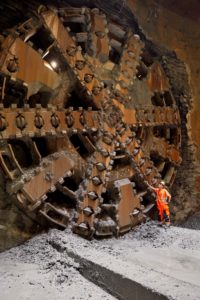 “I am most proud of the team that I have had the pleasure of being a part of,” said Don Smida, Robbins Field Service Technician. The overall scope of a project of this scale is immense, and the amount of daily cooperation & hard work that has been asked of The Robbins Company, the local unions, city staff, and Kenny-Obayashi is extremely important in reaching our common goals. I think we should all be proud of our teamwork going forward from a successful completion of the tunnel and into a successful disassembly of Rosie.”
“I am most proud of the team that I have had the pleasure of being a part of,” said Don Smida, Robbins Field Service Technician. The overall scope of a project of this scale is immense, and the amount of daily cooperation & hard work that has been asked of The Robbins Company, the local unions, city staff, and Kenny-Obayashi is extremely important in reaching our common goals. I think we should all be proud of our teamwork going forward from a successful completion of the tunnel and into a successful disassembly of Rosie.”
Now that tunneling is complete, the machine will be disassembled and removed from its retrieval shaft this autumn. “The Ohio Canal Interceptor Tunnel is the largest public improvement project in our City’s history and a significant investment in our environment and infrastructure that will benefit Akron residents and businesses for generations to come,” said the City of Akron’s Mayor Daniel Horrigan. “Projects of this kind are inherently dangerous, and I am incredibly proud that the tunneling portion was completed without any major injuries, thanks to a dedicated team of professionals. And although Robbins is an international company with worldwide impact, we were pleased to be able to work with a local Northeast Ohio firm on this significant project.”
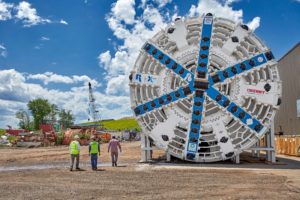 The OCIT Project for the City of Akron, Ohio, USA consists of the construction of a conveyance and storage tunnel system to control Combined Sewer Overflows (CSOs) for several regulators in the downtown Akron area. The EPA-mandated project includes the 1.89 km (1.17 mi) conveyance and storage tunnel, as well as drop shafts, diversion structures, consolidation sewers, and related structures.
The OCIT Project for the City of Akron, Ohio, USA consists of the construction of a conveyance and storage tunnel system to control Combined Sewer Overflows (CSOs) for several regulators in the downtown Akron area. The EPA-mandated project includes the 1.89 km (1.17 mi) conveyance and storage tunnel, as well as drop shafts, diversion structures, consolidation sewers, and related structures.
Image 1: On August 29, 2018, a 9.26 m (30.4 ft) diameter Robbins Crossover TBM broke through at the Akron Ohio Canal Interceptor Tunnel (OCIT).
Image 2: Personnel inspect the Robbins Crossover XRE TBM “Rosie”, named for Rosie the Riveter, after the breakthrough.
Image 3: A crew member cleans the cutterhead of the Robbins Crossover TBM following its breakthrough on August 29, 2018.
Image 4: The Robbins Crossover XRE machine—the first such machine to operate in the U.S.—achieved advance rates of up to 34 m (111 ft) per day in two 10-hour shifts.
Image 5: The 9.26 m (30.4 ft) diameter Robbins Crossover TBM was designed and built in Robbins’ Solon, Ohio, USA facility.
Industry News, trenchless products
 Project: C470 Managed Lanes
Project: C470 Managed Lanes
Owner: CDOT
General Contractor: Flatiron / AECOM Joint Venture
Tunneling Subcontractor: BTrenchless (A Division of BT Construction, Inc.)
BTrenchless is the tunneling subcontractor for Flatiron/AECOM Joint Venture for the expansion of the C470 corridor on the South side of the Denver Metro area.
BTrenchless has completed the following drives on this project:
- 362 LF of 42” RCP was installed using the Akkerman 420 Tunnel Boring Machine.
- 324 LF of 48” RCP was installed using the Akkerman 480 Tunnel Boring Machine.
- 387 LF of 72” RCP was installed using the Akkerman 720 Tunnel Boring Machine.
- 355 LF of 72” RCP. This storm sewer line is in a redesign phase and will be installed using the Akkerman 720 Tunnel Boring Machine.
- 267 LF of 66” RCP. This tunnel is in the final design phase and will be installed using the Akkerman 660 Tunnel Boring Machine.
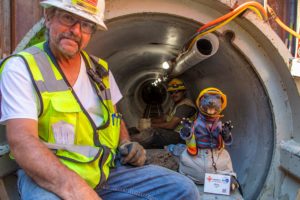 The main challenges encountered during this project were an abandoned 48” steel waterline and an abandoned 12” AC waterline that were found during our 72” RCP tunnel drive. We first encountered the 48” steel waterline and had to remove a section of the waterline through the head of the 720 TBM, as we continued the drive another 30 LF, we encountered a 12” AC waterline that had to be abated and removed through the head of the 720 TBM, as well.
The main challenges encountered during this project were an abandoned 48” steel waterline and an abandoned 12” AC waterline that were found during our 72” RCP tunnel drive. We first encountered the 48” steel waterline and had to remove a section of the waterline through the head of the 720 TBM, as we continued the drive another 30 LF, we encountered a 12” AC waterline that had to be abated and removed through the head of the 720 TBM, as well.
Overall, this tunneling project has been a success for all parties involved, despite the challenges that we have encountered.
As always, Morty the Tunnel Rat is on hand to supervise the project!
Industry News
 The Arab Countries Water Utilities Association (ACWUA), was established in 2009 and has more than 500 individual members and more than 100 water/wastewater utilities from 18 Arab countries.
The Arab Countries Water Utilities Association (ACWUA), was established in 2009 and has more than 500 individual members and more than 100 water/wastewater utilities from 18 Arab countries.
ACWUA will host the Trenchless Arabia Conference and Exhibition on 3-5 March 2019 at King Hussein Bin Talal Convention Centre, Dead Sea, Jordan in conjunction with the 5th Arab Water Week. For details, please visit www.trenchlessarabia.com and https://aww.acwua.org
 Trenchless Arabia is an international conference and exhibition promoting condition assessment (cctv inspection and leak detection), ground penetrating radar (gpr), cured in place pipe (cipp) lining, close-fit sliplining, horizontal directional drilling (hdd), pipejacking, pipe bursting, auger boring, microtunnelling and several other trenchless techniques. Rehabilitation or new installation of underground utilities is possible with trenchless techniques which bring crucial advantages such as minimum surface excavation, less environmental damage, shorter construction period and less social cost.
Trenchless Arabia is an international conference and exhibition promoting condition assessment (cctv inspection and leak detection), ground penetrating radar (gpr), cured in place pipe (cipp) lining, close-fit sliplining, horizontal directional drilling (hdd), pipejacking, pipe bursting, auger boring, microtunnelling and several other trenchless techniques. Rehabilitation or new installation of underground utilities is possible with trenchless techniques which bring crucial advantages such as minimum surface excavation, less environmental damage, shorter construction period and less social cost.
International experts from several institutions, companies and universities will present their best practices and new solutions to the participants from Arab countries. Representatives of ministries, municipalities and utilities from Jordan, Egypt, Lebanon, Palestine, Syria, Iraq, Oman, Bahrain, Yemen, Saudi Arabia, United Arab Emirates (Abu Dhabi, Dubai, Sharjah, Ajman, Umm al-Qaiwain, Ras al-Khaimah and Fujairah), Kuwait, Tunisia, Libya, Algeria, Morocco, Mauritania, Sudan, Qatar, Iran and Turkey will be the key participants. A unique platform will be created among the decision makers, contractors, manufacturers and consultants during the sessions and exhibition.
All NASTT and ISTT members are invited to participate in Trenchless Arabia Conference and Exhibition.
Industry News, trenchless people
 To mark their 45th anniversary, Akkerman is commemorating their years of providing the industry’s best guided boring, microtunneling, pipe jacking and tunneling equipment with valuable educational sessions, equipment displays, factory tours and entertainment.
To mark their 45th anniversary, Akkerman is commemorating their years of providing the industry’s best guided boring, microtunneling, pipe jacking and tunneling equipment with valuable educational sessions, equipment displays, factory tours and entertainment.
SCHEDULE OF EVENTS
SEPTEMBER 18-19
Two days of educational sessions featuring in-depth Factory Certified Hands-On Equipment Training and a Trenchless Technical Seminar on the latest trends, technologies and issues given by industry experts to earn CEU/PDHs.
Hands-On Equipment Training will be offered for GBM, MTBM and TBM System Operation and Maintenance Tracks Schedule
Trenchless Technical Seminar Schedule
- Overview of the ASCE Manual of Practice No. 133: Pilot Tube and Other Guided Boring Methods with Jeff Boschert, P.E., NCPI
- Effective Site Investigation for Determination of Trenchless Technologies with Robert Martin, P.E., Jacobs
- Guided Auger Boring with Jim Weist, Michael Byrne Mfg.
- ASCE Standard 36-15 Standard Design and Construction Guidelines for Microtunneling with Dr. Glenn Boyce, Ph.D., McMillen Jacobs Associates
- Guided Pipe Ramming with Rick Melvin, TT Technologies
- Sliplining with Vince Paparozzi, HOBAS
- Guided Boring with Vitrified Clay Pipe with David Gill, The Logan Clay Products Company
- Lubrication Methods, AZ100 TGS Tunneling Navigation System for Extended and Curved Alignments and Secrets to Successful Long Distance Pilot Tube Installations with Akkerman staff.
Visit the Akkerman website for more info!
 PHILADELPHIA, PA ‐ Pipe Lining Supply is pleased to announce the appointment of Augustus “Gus” Bozzano, II to the position of Technical Representative serving the north eastern USA.
PHILADELPHIA, PA ‐ Pipe Lining Supply is pleased to announce the appointment of Augustus “Gus” Bozzano, II to the position of Technical Representative serving the north eastern USA.
 GSSI
GSSI On August 29, 2018, a 9.26 m (30.4 ft) diameter Robbins Crossover (XRE) TBM crossed the finish line at the Akron Ohio Canal Interceptor Tunnel (OCIT). A press day followed on September 5, where companies and members of the media were invited to view the giant machine. The machine—dubbed “Rosie” in honor of Rosie the Riveter, an icon representing American women who worked in factories and shipyards during World War II—overcame tough ground conditions during the bore.
On August 29, 2018, a 9.26 m (30.4 ft) diameter Robbins Crossover (XRE) TBM crossed the finish line at the Akron Ohio Canal Interceptor Tunnel (OCIT). A press day followed on September 5, where companies and members of the media were invited to view the giant machine. The machine—dubbed “Rosie” in honor of Rosie the Riveter, an icon representing American women who worked in factories and shipyards during World War II—overcame tough ground conditions during the bore. “One of the most challenging aspects of this job was that we launched right into the most difficult part. We had 60 m (200 ft) of soft ground, a very short reach, and then from there we went right into a mixed face for 180 m (600 ft),” said David Chastka, Project Manager for Kenny Construction, a joint venture contractor on the project with Obayashi. “It took everybody we had in the industry, everybody from Robbins, to fight through that first 240 m (800 ft).”
“One of the most challenging aspects of this job was that we launched right into the most difficult part. We had 60 m (200 ft) of soft ground, a very short reach, and then from there we went right into a mixed face for 180 m (600 ft),” said David Chastka, Project Manager for Kenny Construction, a joint venture contractor on the project with Obayashi. “It took everybody we had in the industry, everybody from Robbins, to fight through that first 240 m (800 ft).” The TBM was designed for the project’s geology, which transitioned from soil to partial face shale to full face shale rock. The Crossover XRE included features of both EPB and Hard Rock Single Shield TBM types, with a versatile cutterhead that could be configured for hard rock or soft ground conditions. While in soft ground and mixed face conditions the machine operated in closed mode, but once it hit solid rock crews switched excavation to open mode. “The machine had the power to get to the other side and made advance rates we never thought we were going to get. It was very successful in hard rock,” said Chastka. Advance rates once in full-face shale rock reached a high of 34 m (111 ft) in one day (two 10-hour shifts). Muck removal was achieved using a Robbins continuous conveyor, and conveyor availability remained high throughout the project.
The TBM was designed for the project’s geology, which transitioned from soil to partial face shale to full face shale rock. The Crossover XRE included features of both EPB and Hard Rock Single Shield TBM types, with a versatile cutterhead that could be configured for hard rock or soft ground conditions. While in soft ground and mixed face conditions the machine operated in closed mode, but once it hit solid rock crews switched excavation to open mode. “The machine had the power to get to the other side and made advance rates we never thought we were going to get. It was very successful in hard rock,” said Chastka. Advance rates once in full-face shale rock reached a high of 34 m (111 ft) in one day (two 10-hour shifts). Muck removal was achieved using a Robbins continuous conveyor, and conveyor availability remained high throughout the project. “I am most proud of the team that I have had the pleasure of being a part of,” said Don Smida, Robbins Field Service Technician. The overall scope of a project of this scale is immense, and the amount of daily cooperation & hard work that has been asked of The Robbins Company, the local unions, city staff, and Kenny-Obayashi is extremely important in reaching our common goals. I think we should all be proud of our teamwork going forward from a successful completion of the tunnel and into a successful disassembly of Rosie.”
“I am most proud of the team that I have had the pleasure of being a part of,” said Don Smida, Robbins Field Service Technician. The overall scope of a project of this scale is immense, and the amount of daily cooperation & hard work that has been asked of The Robbins Company, the local unions, city staff, and Kenny-Obayashi is extremely important in reaching our common goals. I think we should all be proud of our teamwork going forward from a successful completion of the tunnel and into a successful disassembly of Rosie.” The OCIT Project for the City of Akron, Ohio, USA consists of the construction of a conveyance and storage tunnel system to control Combined Sewer Overflows (CSOs) for several regulators in the downtown Akron area. The EPA-mandated project includes the 1.89 km (1.17 mi) conveyance and storage tunnel, as well as drop shafts, diversion structures, consolidation sewers, and related structures.
The OCIT Project for the City of Akron, Ohio, USA consists of the construction of a conveyance and storage tunnel system to control Combined Sewer Overflows (CSOs) for several regulators in the downtown Akron area. The EPA-mandated project includes the 1.89 km (1.17 mi) conveyance and storage tunnel, as well as drop shafts, diversion structures, consolidation sewers, and related structures. Project: C470 Managed Lanes
Project: C470 Managed Lanes The main challenges encountered during this project were an abandoned 48” steel waterline and an abandoned 12” AC waterline that were found during our 72” RCP tunnel drive. We first encountered the 48” steel waterline and had to remove a section of the waterline through the head of the 720 TBM, as we continued the drive another 30 LF, we encountered a 12” AC waterline that had to be abated and removed through the head of the 720 TBM, as well.
The main challenges encountered during this project were an abandoned 48” steel waterline and an abandoned 12” AC waterline that were found during our 72” RCP tunnel drive. We first encountered the 48” steel waterline and had to remove a section of the waterline through the head of the 720 TBM, as we continued the drive another 30 LF, we encountered a 12” AC waterline that had to be abated and removed through the head of the 720 TBM, as well. The Arab Countries Water Utilities Association (ACWUA), was established in 2009 and has more than 500 individual members and more than 100 water/wastewater utilities from 18 Arab countries.
The Arab Countries Water Utilities Association (ACWUA), was established in 2009 and has more than 500 individual members and more than 100 water/wastewater utilities from 18 Arab countries. Trenchless Arabia is an international conference and exhibition promoting condition assessment (cctv inspection and leak detection), ground penetrating radar (gpr), cured in place pipe (cipp) lining, close-fit sliplining, horizontal directional drilling (hdd), pipejacking, pipe bursting, auger boring, microtunnelling and several other trenchless techniques. Rehabilitation or new installation of underground utilities is possible with trenchless techniques which bring crucial advantages such as minimum surface excavation, less environmental damage, shorter construction period and less social cost.
Trenchless Arabia is an international conference and exhibition promoting condition assessment (cctv inspection and leak detection), ground penetrating radar (gpr), cured in place pipe (cipp) lining, close-fit sliplining, horizontal directional drilling (hdd), pipejacking, pipe bursting, auger boring, microtunnelling and several other trenchless techniques. Rehabilitation or new installation of underground utilities is possible with trenchless techniques which bring crucial advantages such as minimum surface excavation, less environmental damage, shorter construction period and less social cost. To mark their 45th anniversary,
To mark their 45th anniversary,